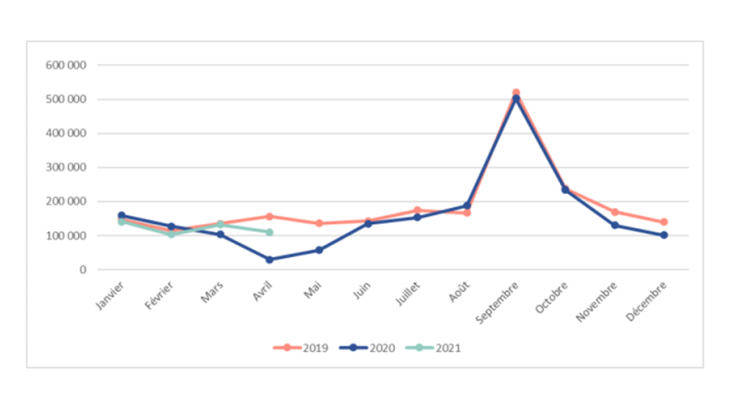The health restrictions weighing on economic activity since March 2020 have resulted in a sharp decline in demand for labour from businesses. This has particularly affected young people, whose unemployment rate was already around 20% in France before the pandemic. Indeed, the integration of young people into the labour market has become even more difficult: the number of hirings of young people under the age of 26 on permanent or fixed-term contracts of over 3 months decreased throughout the year 2020. The same holds true for internships, the number of which fell by 22% over the year (Dares).
Structurally, young people without degrees are the most likely to experience episodes of unemployment (Müller, 2005). The health crisis has worsened their situation: at the beginning of May, there were almost twice as many new entrants to the youth guarantee scheme (a scheme to help young people aged 16 to 25 in very precarious situations find employment or training) as there were during the same period in 2020 (Dares). This increase is worrying insofar as it is difficult for young people who have lost contact with the labour market to get back into it.
This observation may be put into perspective in view of the economic recovery. The employment rate improved in 2021, reaching 32.8% in the third quarter, a level unseen in France for 20 years. However, youth employment remains low in France by international standards, particularly compared to Germany, where the unemployment rate for 15-24 year-olds is around 5.5%, compared to 20% in France in the third quarter of 2021.
Employment support measures have promoted long-term contracts
Faced with the increase in the share of NEETs (young people not in education, employment or training) after the first lockdown, the government's response has focused on short-term measures to support employment. In this respect, the "1 jeune, 1 solution" plan has made it possible to increase businesses’ demand for labour and to help young people integrate the labour market. It continues with the recent announcements of a "universal" youth guarantee scheme, raising the number of open places to 200,000.
The main measure was the EUR 4,000 bonus granted to businesses when hiring a young person. According to a recent DARES assessment, the hiring bonus has had a positive impact on the employment of young people aged 22 to 25 in permanent or fixed-term contracts (up 7%). However, this assessment emphasises that the net effect on total employment is nil: the bonus has mainly led to a shift from short-term and temporary contracts to long-term contracts.
The income of students who were working at the same time has decreased
Now, short-term contracts are particularly widespread among students and had already been negatively impacted by the crisis (temporary employment shrank in April 2020). According to the Observatoire de la Vie Etudiante, about 1 in 7 students have a paid job that is considered essential to their livelihood and that interferes or interferes greatly with their studies.
Among these students who work alongside studying, 35.8% report a loss of income during the March 2020 lockdown and 19.4% did not return to work after it. Thus, in the 2020-2021 academic year, the share of students without any paid activity increased by 8 percentage points compared to the 2019-2020 academic year (OVE, 2021).
These income losses put students at risk of dropping out of education at a time when employment rates are higher among graduates (Machin et McNally, OCDE, 2007). Furthermore, young people who are currently in education are postponing their entry into the labour market.
We are proposing financial incentives for further study
Financial incentives for further study can thus be aimed at decongesting the youth labour market by limiting the labour supply. They are therefore a response to the shock triggered by the crisis as well as to the structural issue of youth unemployment. So far, the category of grant holders has been able to enjoy EUR 1 meals and occasional financial aid has been granted. However, rents, which are the main expense for all students, have remained stable. As a result, additional redistribution measures could be granted.
According to Fack et Grenet (2015), raising grants to EUR 1,500 per year would increase the enrollment rate by 3 percentage points, by almost 5 for the first years of a bachelor's degree, and the graduation rate would increase by 3%. Expanding the criteria for the tier 1 grant would also increase enrollment in bachelor's and master's programmes and the likelihood of graduation (Fack et Grenet, 2013). Going further in the allocation procedures, the proposal of a "universal youth income" (Philippe Aghion) should be highlighted. This measure could have an experimental dimension.
Still in the perspective of increasing access to education, it is important to improve the bridges between professionally trained youth and higher education (OCDE, 2020). This category of the population could "take advantage" of the health crisis to develop their skills and improve their qualifications.
The effectiveness of these measures may depend on announcement effects
University enrollment rates are higher when young people have money for their education in a bank account in advance (Geven et Herbaut, 2019). Knowing as early as possible that grants will be awarded is likely to increase enrollment rates.
